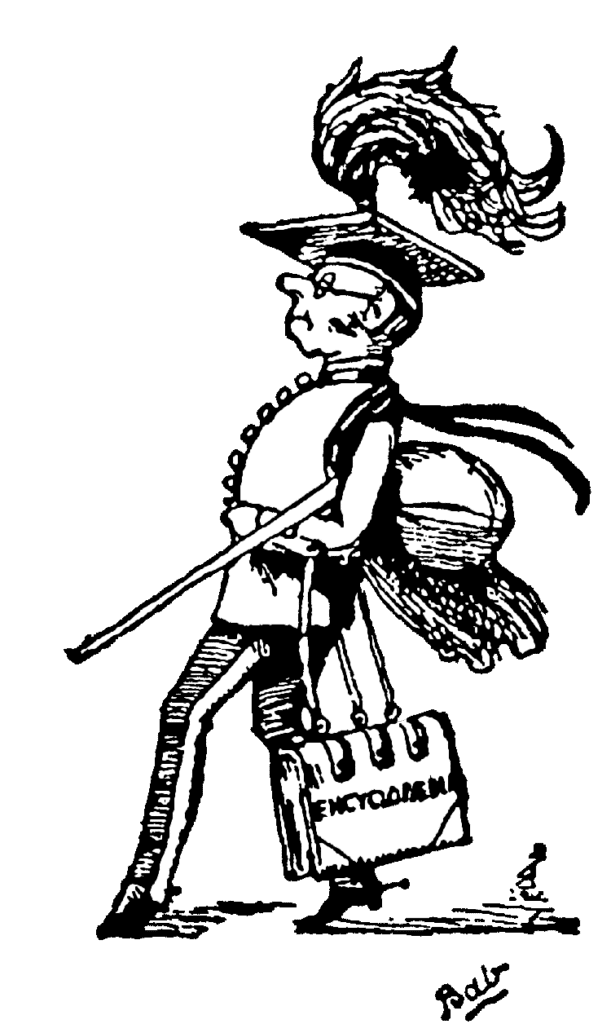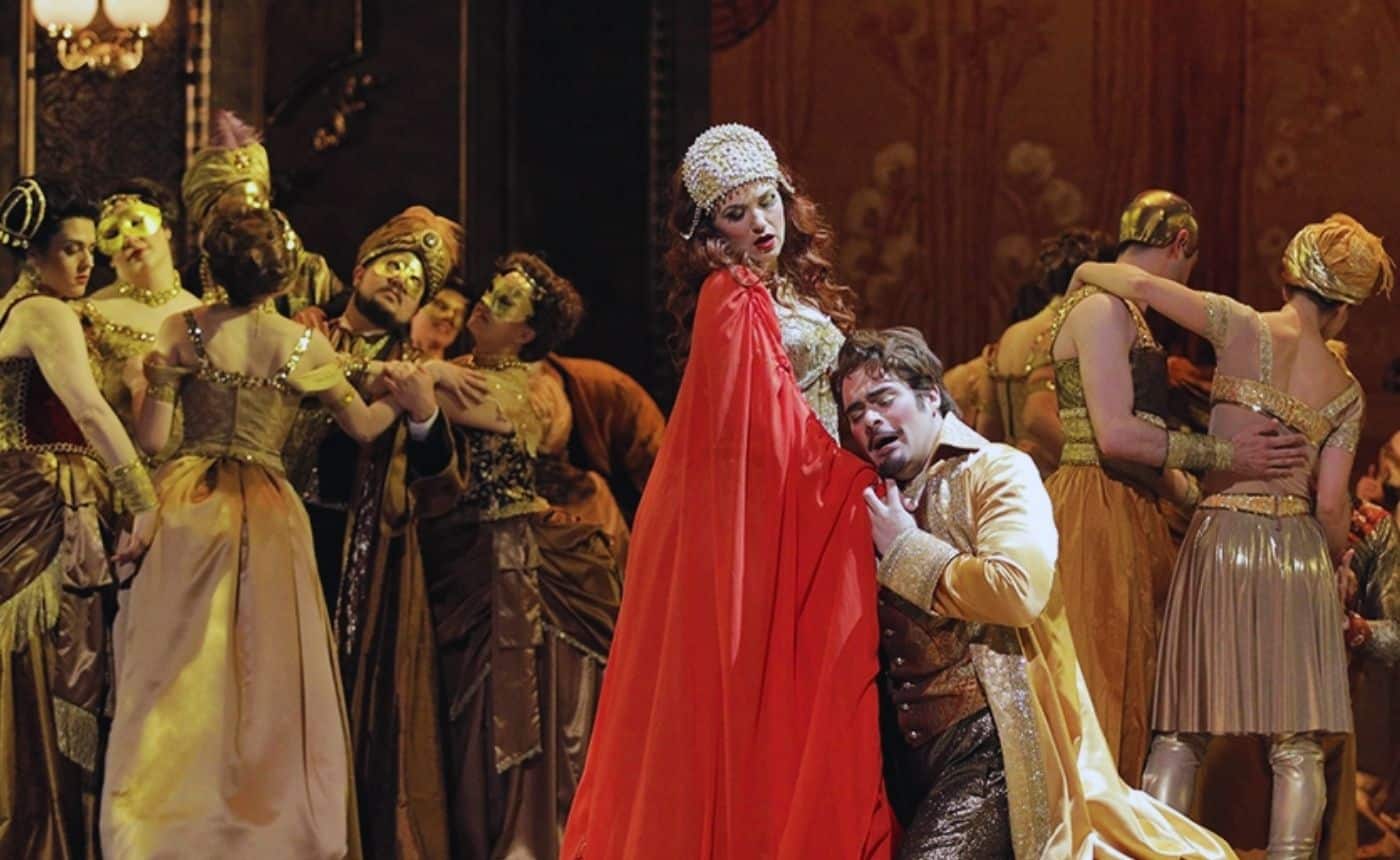The Pirates of Penzance online course by Dr. Glen W. HicksPART 2. Patter and Parody
One of the most beloved songs from The Pirates of Penzance (1879), and perhaps from any of Gilbert and Sullivan’s operettas, is sung by the venerable Major-General Stanley near the close of Act 1. “I am the very model of a modern Major-General” is a galloping, fast-paced, rhythmic song in which the caricature of an English army officer rattles off his many of his skills, and even a few of his shortcomings. While the song is replete with Victorian satire, it has lodged itself firmly within modern popular culture through repetition and parody.
“I am the very model” is a type of composition known as a “patter song.” Today, patter songs are defined as songs that are sung at a rapid tempo where each syllable in the phrase is represented by one note. Some scholars argue that the term “patter” originated with the Catholic prayer known as the Pater Noster, or Lord’s Prayer, which was often recited hastily – “patter” becoming a corrupted form of Pater. Laura Kasson Fiss observes that by the 1830s, “patter” was used to describe the rapid talking patterns of merchants and street vendors selling goods.[1] Their rhythmic calls would carry through the noisy streets and draw the attention of people passing by. However, the musical use of patter extends beyond the practical to encompass the ridiculous.
By the time Pirates was written, patter songs had become synonymous with comical situations or characters and were often virtuosic showpieces for a bass or baritone. Take for instance the Major General’s song, “I am a Very Model.” Throughout the chorus Major General Stanley rapid-fire delivery of his attributes is only interrupted by his own hesitation as he searches just the right words to complete his rhymes. Consequently, he delivers such gems as
lot o’ news . . . hypotenuse
calculus . . . animalculous
mineral . . . Gineral
Sir Caradoc’s . . . paradox
Heliogabalus . . . parabolous
Strategy . . . sat a gee

At one point, the song’s rhymes even poke fun at its immensely popular predecessor, H.M.S. Pinafore (1878).
Then I can hum a fugue of which I’ve heard the music’s din afore,
And whistle all the airs from that infernal nonsense Pinafore.
Gilbert and Sullivan’s reference to their operetta Pinafore is a tongue-in-cheek nod to the work’s formidable popularity that early audiences would have quickly noticed.
Pirates was not the first nor the last time Gilbert and Sullivan would use the technique in their operettas. In the 1877 operetta The Sorcerer, the song “My name is John Wellington Wells” makes effective use of the patter technique with alliterative words and driving rhythms. The operetta, Iolanthe; or, The Peer and the Peri, was written for the Savoy Theater in London in 1882 and follows the story of the fairy Iolanthe, who has been banished from fairyland for marrying a mortal. The operetta generally satirizes various aspects of law and society. The patter song “When you’re lying awake,” which is sung by the Lord Chancellor, describes his battle with insomnia and the dreams that come to him when he finally does get to sleep. Another of Gilbert and Sullivan’s patter song occurs in the operetta Ruddigore; or, The Witch’s Curse, also written for the Savoy Theater and premiered in 1887. Set in Cornwall, the operetta is filled with ghosts, wicked baronets, and young maidens. The pattering text of “My eyes are fully open to my awful situation” gets tossed between three performers who continually get stuck on the word matter, matter, matter, matter, matter, matter, matter…
These works represent only a few of the patter songs found throughout Gilbert and Sullivan’s catalogue. And while they represent some of the most famous examples of patter songs, the inspiration for them came from several older sources.
Both Gilbert and Sullivan were familiar with Italian opera and often parodied characteristics from the works of composers like Wolfgang Amadeus Mozart (1756-1791), Gioachino Rossini (1792-1868), and Gaetano Donizetti (1797-1848). Among the characteristics that Gilbert and Sullivan borrowed were the fast-paced, syllabic songs that are often found in opera buffa, or comic opera. While these early composers may not have used the term “patter,” their songs possess many of the same traits found in later iterations. The following are just a few examples of songs and arias from the eighteenth and nineteenth centuries that contain patter-like moments:
“Non ti voglio,” from Tiberio imperatore d’Oriente (1702) by Alessandro Scarlatti
“Son imbrogliato io” from La serva padrona (1733) by Giovanni Battista Pergolesi
“Se tutto il codice” from The Marriage of Figaro (1786) by Wolfgang Amadeus Mozart
“Largo al Factotum” from The Barber of Seville (1816) by Gioachino Rossini
“Quello brontola e borbotta” from La Cenerentola (1817) by Gioachino Rossini
“Cheti, cheti, immantinente” from Don Pasquale (1843) by Gaetano Donizetti
“Bin Akademiker” from The Barber of Bagdad (1858) by Peter Cornelius
In the twentieth century many other composers of musical theater and popular music songwriters have incorporated elements of patter song into their works:
“Tchaikovsky” from Lady in the Dark (1941) by Kurt Weill and Ira Gershwin
“Ya Got Trouble” from The Music Man (1957) by Franklin Lacey and Meredith Willson
“Getting Married Today” from Company (1970) by Stephen Sondheim and George Furth
“All for the Best” from Godspell (1971) by Stephen Schwartz and John-Michael Tebelak
“We Didn’t Start the Fire” from Storm Front (1989) by Billy Joel
“One Week” From Stunt (1998) by Barenaked Ladies
Even with all of these different iterations of patter songs, “I am the very model” from the Pirates of Penzance has remained at the forefront of popular culture. Its tune and has been used on numerous occasions in parodies by professional entertainers, cartoon characters, and social media influencers.
In the 1960s the American songwriter and satirist Tom Lehrer (1923- ) set the periodic table to Sullivan’s music and created a sensation with his rapid-fire delivery of the chemical elements.
With the creation of the Animaniacs cartoon series in 1993, a new generation of audiences was exposed to “The Major-General’s Song.” In one of the episodes, the main characters, Yakko, Wakko, and Dot, sing “I am the very model of a cartoon individual,” much to the chagrin of a hapless pirate.
“I am the very model” made it to the big screen once again in 2017 when it was included as part of Despicable Me 3. In this scene, the minions find themselves on stage as part of an American Idol-like reality show. As the music starts, the minions give an impassioned, yet nonsensical, version of Gilbert and Sullivan’s original tune.
The song continues to be parodied and it is possible to find a version to fit just about any situation. While their subjects may differ wildly, many retain the same spirit of the original through their use of satire and humor. Some of these iterations include:
“I am the very model of a very stable genius.”
“I am the very model of effective social distancing.”
“I am the very model of a modern major liberal.”
“I am the very model of a biblical philologist.”
“I am the very model of a modern U.S. president.”
Just as the song originally served as a commentary on the British military, education, and social structures, these modern parodies serve as forms of protest, advocacy, and social commentary. As current events continue to unfold across the globe, it would be unsurprising if the Major-General continues to find a voice amongst the commotion.
[1] Laura Kasson Fiss, “‘This Particularly Rapid, Unintelligible Patter’: Patter Songs and the Word-Music Relationship.” Chapter 7 (pp. 98-108) in The Cambridge Companion to Gilbert and Sullivan. New York: Cambridge University Press. 2009.





